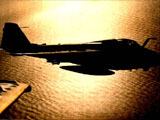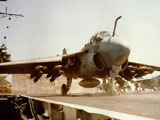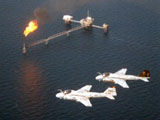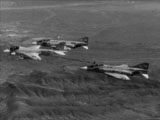
|


A-6 Intruder


| Primary Function: | All-weather medium attack aircraft |
| Contractor: | Grumman Aerospace Corporation |
| Unit Cost: | $22 million |
| Propulsion: |
| All Model | Two Pratt & Whitney J52-P8B engines |
| E model, post 1991 | Two Pratt & Whitney J52-409 engines |
| Thrust |
| All Model | 9,300lb (4,218kg) |
| E,post 1991 | 12,000lb (5,443kg) |
| Dimension |
| Wingspan: | 53 feet (16.1 meters) |
| Length: | 54 feet 7 inches (16.1 meters) |
| Height: |
| A/C | 15 feet 7 inches (4.74 meters) |
| E | 16 feet 3 inches (4.95 meters) |
| Weight: | Take-off maximum gross, 60,626 pounds (27,524 kg);
take-off maximum gross(carrier), 58,600 pounds (26,370)
kg); empty, 25,630 pounds (11,636 kg) |
| Performances |
| Speed: | 563 knots (648 miles, 1036 km, per hour) |
| Ceiling: | 44,600 feet |
| Range: | With full combat load, 1,077 miles (1,733 km); with external fuel tanks, 3,100 miles (4,991 km) |
| Armament: |
| Five stores locations each rated at 3,600 pounds (1,634 kg)
carrying any combination of Mk 80 series GP bombs, Guided Bomb Units (GBUs)
, AGM-65 Maverick missiles, AGM-88 Harm missile
, AGM-84D Harpoon missiles, AIM-9 Sidewinder missile, and the AGM-62 Walleye. |
| Crew: | Two |
| Date Deployed: |
| First flight, April 19, 1960 |
| Operational, February 1963 |

In 1956, the Navy requested a "Carrier borne all weather attack aircraft", its size was to be bigger then the A-4 Skyhawk but smaller then the A-3 Sky Warrior. The requirement also emphasized on the ability to fly a long-range mission at low altitude and be capable of performing its mission even in bad weather. The plane must also be capable of navigating through terrain without help of external sources such as beacons.
7 companies responded to the request and Grumman's model 128 was selected as the winner. Initially the plane was designated as A2F-1 and later redesignated as A-6. Eight-test plane was ordered and the first A-6 flew on 19 April 1960. 482 A-6 was delivered to the Navy, the first being in February 1963.
The A-6 first saw action in the Vietnam War when USS Independence sailed into the Gulf of Tokin's with VA-75 on board. With the Vietnam War escalating in 1965, the A-6 DIANE system endowed an excellent operating ability in all weather conditions. With the cancellation of the A-12 program, the Navy continued to upgrade it's A-6E fleet. The E model was rewinged with composite material, SWIP was introduced to expand the weapon capability and new HUD and extra fuel was also introduced to the Intruder. The A-6 served with 14 Navy attack squadron and 5 USMC squadrons.

|
A-6B | is a variant of the A model, 19 was produced. It was designed for SAM suppression in the Vietnam War. |
|
A-6C | 12 was produced, designed with turret mounted FLIR and LLLTV equipment for improved night attack capability |
|
KA-6D | 78 was produced; the model was given the mission of tanking other planes during flight operations. It is equipped with TACAN and the buddy refueling system. The KA-6D is the Navy's standard tanker. |
|
A-6E | first flown on 27th February 1970, it introduced a multi-mode navigation attack radar and a computerised nav/attack system. Most navy and USMC A-6E were updated in 1974 with a TRAM laser designator and FLIR turret giving smart weapon capability. |
|
A-6F | Similar airframe to the E model except with improved digital avionics, new radar and F404 turbofans. The Navy canceled the F model when it opted to continue with its A-12 program. |
|
A-6G | Similar to the F model except it retained the J52 engines
|

The A-6E is an all-weather, two-seat, subsonic, carrier-based attack
aircraft. In spite of its weight, it has excellent slow-flying capabilities with full
span slats and flaps. The crew, sitting side by side, can see in all directions through
a broad canopy. The aircraft is equipped with a micro-miniaturized digital computer,
a solid state weapons release system, and a single integrated track and search radar.
The Intruder is armed with laser-guided weapons and equipped with a chin turret containing
a forward-looking infra-red (FLIR) system and laser designator and receiver.
The A-6 worked around the clock in Vietnam, conducting attacks on the targets with a
pinpoint accuracy unavailable through any other aircraft at that time.The A-6E proved
once again that it is the best all-weather precision bomber in the world in the joint strike
on Libyan terrorist-related targets in 1986. Navy A-6E Intruders and Air Force FB-111s
penetrated the sophisticated Libyan air defense systems, which had been alerted by the
high level of diplomatic tension and by rumors of impending attacks. Evading more than
100 guided missiles, the strike force flew at low levels in complete darkness and hit its
target. A-6 aircraft were used extensively during Operation Desert Storm, providing
precision bombing on a wide range of targets. The night and all-weather attack capabilities
enabled the A-6 to neutralize anti-aircraft batteries and attack well- protected tactical
targets with minimum casualties. The precision munitions used by the A-6 provided exact
targeting of targets in a complex environment.

|
 |

DIANE System
|
Digital Integrated Attack Navigation Equipment |
AN/APQ-92
Main search radar, provide both a navigation and attack facility
AN/APQ-122
Tracking radar for terrain mapping and traget location
AN/APN-141
Low altitude (up to 1524m -5000 ft)radar altimeter
AN/APN-153
Doppler radar for navigation and to provide ground speed and drift angles for ballistic computer
AN/ANS-31
Inertial navigation system, provide data on heading altitude and horizontal and vertical velocities
AN/ASQ-57
Integrated electronic control system
AN/ASQ-61
Ballistic Computer, provides flight pattern data, cruise control and data for weapons selection, fuzing and delivery
AN/ASW-16
Three axis autopilot
AN/AVA-1
Pilots display unit, provide data on flight parameters, such as terrain clearance
CPA-728A
Air data computer which provides altitude static pressure, Mach numver and airspeed information for the ASW-16, the AVA-1 and the conventional flight instrument |
|  |

 A-6
A-6
 A-6 loaded ready for takeoff
A-6 loaded ready for takeoff
 A-6 during Gulf War
A-6 during Gulf War
 KA-6D fueling 2 F-4
KA-6D fueling 2 F-4
|
|  |

|


This page hosted by  Get your own Free Home Page
Get your own Free Home Page
|












 A-6
A-6 A-6 loaded ready for takeoff
A-6 loaded ready for takeoff A-6 during Gulf War
A-6 during Gulf War KA-6D fueling 2 F-4
KA-6D fueling 2 F-4